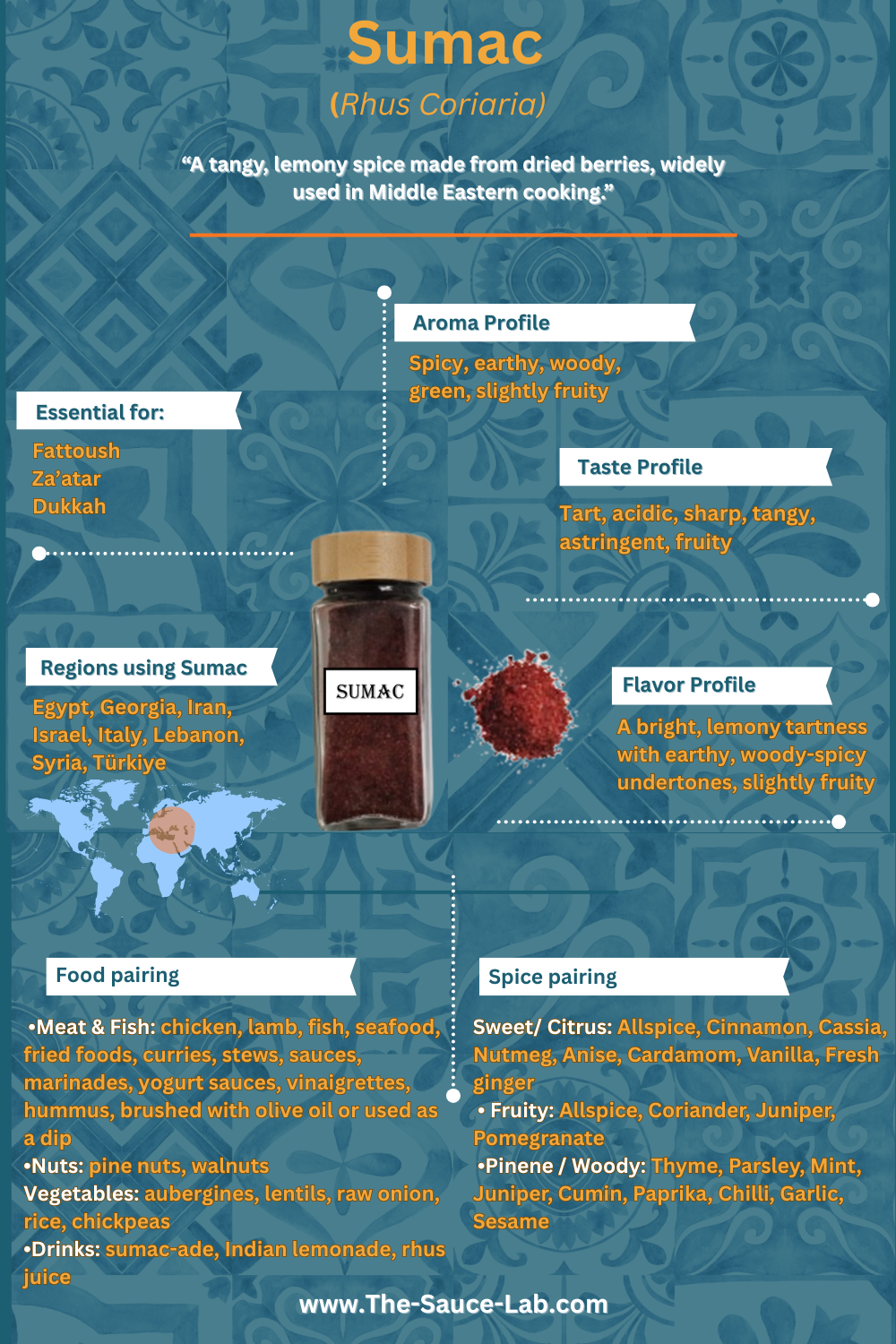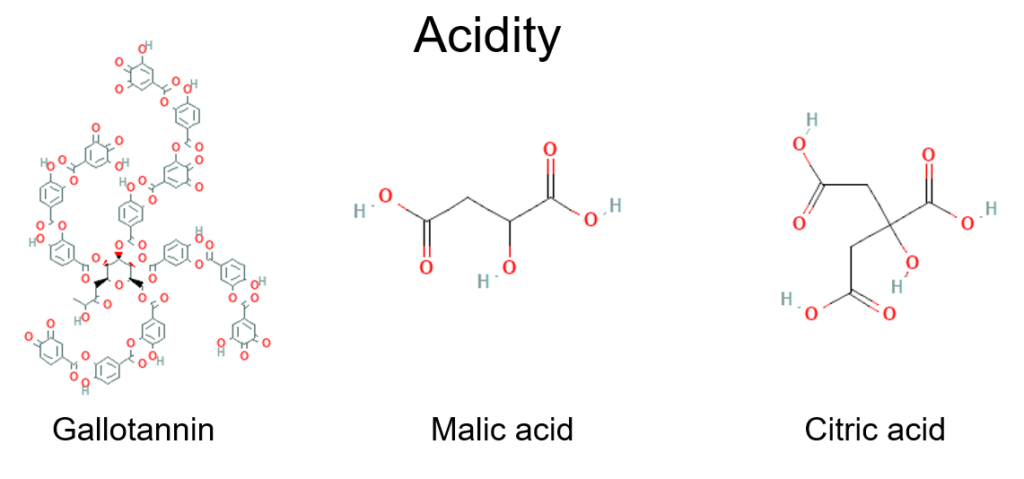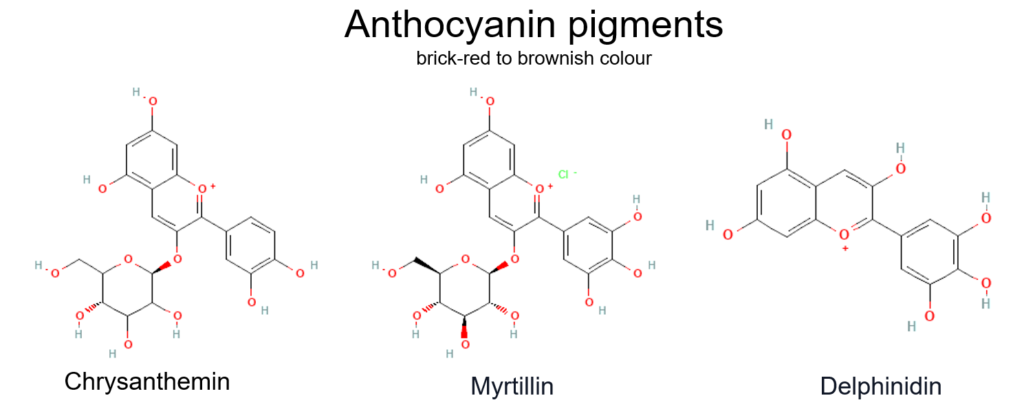Sumac spice – The Salt and Pepper of the East

General Information
Sumac is widely utilized in the Middle East as a spice, used in food, desserts, and drinks. The name derives from the Arabic root summaq, “red,” referring to the red color of the fruit (1).
Sumac belongs to the genus Rhus, which is spread across temperate and subtropical regions. There are around nine species that are used as spices, including Sicilian sumac (Rhus coriaria), Chinese sumac (R. chinensis), smooth sumac (R. glabra), staghorn sumac (R. typhina), fragrant sumac (R. aromatica), lemonade sumac (R. integrifolia), sugar sumac (R. ovata), and Muller’s sumac (R. mulleria) (1).
It is a bushy shrub that reaches up to 3 m (10 ft) in height, with red drupaceous fruits that will dry and be ground as a spice. In the United States, several species of sumac are invasive. Wild thickets grow on open hills and upper plateaus along the Mediterranean, across Anatolia (Türkiye), and throughout the Middle East. Its color ranges from brick red to brown and depending on the region. It is harvested from late July to early September and sometimes into early autumn (1).
Culinary Usage
Sumac is widely distributed in Near Eastern and Mediterranean countries (Egypt, Georgia, Iran, Israel, Italy, Lebanon, Syria, and Türkiye). The aroma and flavor have been described as spicy, earthy, woody, green, slightly fruity, tart, acidic, sharp, tangy, and astringent. The flavor is an equilibrium of bright, lemony tartness and earthy, spicy-woody depth.
The berries can be used whole or ground. Steeped in water for 20–30 minutes, they yield a tangy infusion for marinades, dressings, or drinks. Ground sumac is just as convenient: it can be used as a topping over foods, as a rub on meats or vegetables, or as an addition to spice mixtures.
Sumac is essential to za’atar, a blend with toasted sesame seeds, thyme, and salt (one of the variations). It also appears and flavors with its citrus taste the Labanon bread salad fattoush. You can use sumac for seasonings meat, in curries, fish, rice, salads, stews, and sauces in Arab cuisine. It is traditionally combined with olive oil as a dip for bread, with onions and salt for roasted meat, or mixed into hummus. It also seasons marinades, yogurt sauces, and vinaigrettes.
Among the Native Americans, sumac fruits were use to make beverages such as sumac-ade, or Indian lemonade, or rhus juice. It was prepared by soaking the ripe fruit in water, gently rubbing them to squeeze out their juice, straining through a cloth, and sweetening (1, 5, 6, 7).
Dishes Where Sumac Is Essential
- Za’atar spice blend – traditional za’atar mix almost always include sumac alongside thyme, sesame seeds, and salt.
- Musakhan (Palestinian chicken with onions and sumac) – a classic Palestinian dish where sumac gives the onions their signature tang.
- Fattoush (Levantine bread salad) – the dressing depends on sumac for its sour brightness.
- Parsley and sumac salad – here, sumac is the star ingredient.
- Middle Eastern thyme breads (mana’eesh/za’atar bread) – topped with za’atar, which contains sumac.
- Sumac onions – thinly sliced onions tossed with sumac are a staple garnish in Turkish and Levantine cuisines.
- Piyaz (Turkish bean salad) – the dressing is traditionally flavored with sumac.
- Turkish potato salad – lemon and sumac make this salad distinctively Turkish.
- Gavurdağı (Turkish tomato–walnut salad) – relies on sumac for its lemony flavour.
- Sumac Lemonade or Sumac-ade – refreshing summer drink
Recipes vary, and sumac is often used as a seasoning or garnish but isn’t mandatory.
- Azerbaijani potato slices with herbs – sumac is commonly sprinkled over potatoes and fresh herbs in Azerbaijani cuisine.
- Shawarma – some spice blends include sumac, while others don’t. It’s also sometimes sprinkled on top after cooking.
- Middle Eastern style lamb pizzas – sumac may appear in the seasoning, depending on the recipe.
- Chicken thighs in yogurt and onions – not always, but sumac pairs beautifully with the marinade.
- African spice mix with sumac – depends on the specific regional blend.
Modern or Non-Traditional Uses of Sumac
These recipes aren’t historically linked with sumac, but chefs often add it for extra brightness.
- Tahini devilled eggs – a dusting of sumac makes a striking garnish.
- Spiced kumara (sweet potato) dip with flatbread – sumac adds citrusy depth.
- Roasted red capsicum soup – some modern recipes finish it with sumac.
- Tofu sour cream with sumac – a creative vegan application of the spice.
Combines Well With:
· Allspice
· Chili
· Coriander
· Cumin
· Garlic
· Mint
· Paprika
· Parsley
· Sesame
· Pomegranate
· Thyme
· Nutmeg
· Cinnamon
· Cassia
· Anise
Chemical and Functional Properties
The leaves, fruit, and bark of Sumac are rich in many chemical constituents. Essential oil analysis has shown:
• Leaves: ~60 compounds, led by β-caryophyllene and patchoulane.

• Bark/branches: ~63 compounds, mainly β-caryophyllene and cembrene.

• Fruits: up to 85 compounds, dominated by limonene, nonanal, and (Z)-2-decenal.

Ground sumac’s flavor is lemony, acid, woody, and spicy. Acidity is caused by tannins (gallotannins) and organic acids such as malic, citric, tartaric, succinic, maleic, fumaric, and ascorbic acids. Sensory tests showed that malic acid was mostly responsible for sourness (1).

Spicy and woody flavors are caused by β-caryophyllene, whereas cembrene and caryophyllene oxide are responsible for woody and spiciness, respectively.

Sumac fruits also contain anthocyanin pigments such as chrysanthemin, myrtillin, and delphinidin (1).

⚠️ Safety note: Sumac fruit and other plant material may contain urushiols (3-alkyl pyrocatechol derivatives) containing, potent allergens also present in poison ivy. Small amounts can induce dermatitis, while ingestion or inhalation can result in serious reactions involving mucous membranes (1).

Biological Activities
Sumac extraction has a wide range of biological activities including antifibrogenic, antifungal, anti-inflammatory, antimalarial, antimicrobial, antimutagenic, antioxidant, antithrombin, antitumorigenic, antiviral, cytotoxic, hypoglycemic, and leukopenic activity (1,2,3,4).
Buying & Storing Sumac
• Purchase whole berries if available—dried berries keep longer and ratain more flacour than the powdered form.
• Availability: try searching for it at Middle Eastern markets, specialty food stores, better grocery stores, or online.
• Freshness tip: good sumac will have a strong, lemony scent.
Storage
• Store sumac in an airtight container.
• Store in a cool, dark, dry place, away from heat and dampness.
• Shelf life: ground sumac will keep for a few months, while whole berries will keep for one or more years.
References:
1. Peter, K. V. (Ed.). (2012). Handbook of herbs and spices: Vol. 2 (2nd ed.). Woodhead Publishing. https://doi.org/10.1533/9780857095688
2. Abachi, S., Macé, S., Lee, S., & Rupasinghe, H. P. V. (2022). Cranberry and sumac extracts exhibit antibacterial and anti-adhesive effects against Streptococcus pyogenes. Journal of Medicinal Food, 25(3), 235–242. https://doi.org/10.1089/jmf.2021.0047
3. Martinelli, G., Angarano, M., Piazza, S., Fumagalli, M., Magnavacca, A., Pozzoli, C., Khalilpour, S., Dell’Agli, M., & Sangiovanni, E. (2022). The nutraceutical properties of sumac (Rhus coriaria L.) against gastritis: Antibacterial and anti-inflammatory activities in gastric epithelial cells infected with H. pylori. Nutrients, 14(9), 1757. https://doi.org/10.3390/nu14091757
4. Rayne, S., & Mazza, G. (2007). Biological activities of extracts from sumac (Rhus spp.): A review. Plant Foods for Human Nutrition, 62(4), 165–175. https://doi.org/10.1007/s11130-007-0058-4
5. Norman, J. (2015). Herbs & spices: Over 200 herbs and spices, with recipes for marinades, spice rubs, oils, and more. DK Publishing
6. Lakshmi, P. (2016). The encyclopedia of spices & herbs: An essential guide to the flavors of the world (J. Sutton & Kalustyan’s, Eds.). HarperCollins.
7. Farrimond, S. (2018). The Science of Spice: Understand flavour connections and revolutionize your cooking. Dorling Kindersley Ltd.
8. All the chemical formulas are from – https://pubchem.ncbi.nlm.nih.gov/
